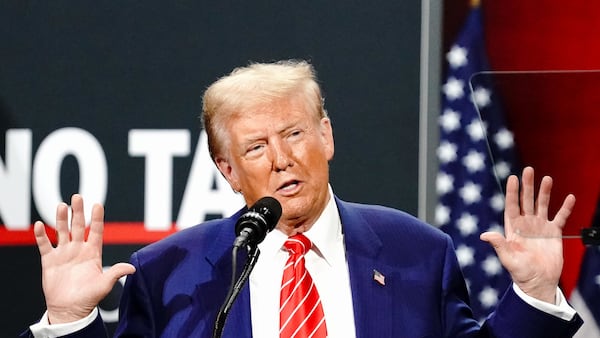- Non-crypto firms are actively muscling into digital assets.
- We asked Revolut, Robinhood, and Fidelity Digital Assets among other firms to share what they’re watching in 2025.
- Their answers covered AI, regulation, tokenisation and much more.
Wall Street’s coming for crypto.
Over the past 12 months, traditional finance has muscled into the realm of digital assets like never before.
In 2024, industry powerhouses like BlackRock and Franklin Templeton launched spot Bitcoin exchange-traded funds; and fintechs like Robinhood and Stripe announced plans to acquire crypto companies.
Elsewhere neobank Revolut and bank-funded firms like Zodia Custody expanded their crypto offerings.
Sixteen years after Satoshi Nakamoto launched Bitcoin as an alternative to the system that created the 2008 financial crisis, crypto has become part of that very system.
The traditional finance, or TradFi in crypto parlance, creep shows no sign of stopping.
So what’s next? We asked leading fintechs, asset managers, banks and crypto firms backed by traditional finance players what they’re looking for in 2025.

Julian Sawyer, CEO, Zodia Custody
The next year will be pivotal: a bullish outlook on digital assets with greater global clarity on regulations are set to make 2025 perhaps the most pivotal year for growth.
Many are optimistic that the US will prioritise codifying regulations, helping it catch up with mature markets and drive innovation.
In particular the recently nominated Securities and Exchange Commission chair is expected to support the implementation of a digital asset regulatory framework and overturn the SAB 121 guideline, providing further clarity and confidence to investors.
In Europe, the full introduction of the long-gestating Markets in Crypto-Assets, or MiCA, legislation will mean investors and industry participants will have a clear runway, helping to bring previously disparate regulatory approaches together and put Europe on a far stronger footing.
There are reasons to be optimistic beyond regulation.
Tokenisation of real-world assets is perhaps the single-most important innovation that will truly unleash the potential of digital assets, as businesses and institutions seek more efficient ways to digitise and trade tangible assets.
These trends signal a maturing industry, expanding blockchain’s utility-expanding cryptocurrencies.
As trust grows, 2025 could mark a new era of institutional and retail participation, reinforcing digital assets as an integral part of the global financial landscape.

Leonid Bashlykov, head of product — crypto, Revolut
The crypto industry finds itself on a great footing heading into 2025, particularly given the recent all-time highs we’ve experienced in recent weeks.
A shift in the political situation in the US could create a positive path for crypto’s future globally.
2025 was always going to be big from a regulatory perspective no matter the SEC’s stance thanks mainly to the advent of MiCA across the European Economic Area, which brings much greater clarity on how to operate in the market.
Meanwhile in the UK, the Financial Conduct Authority has published a Crypto Roadmap, which has provided additional clarity in terms of crypto-specific legislation.

Johann Kerbrat, general manager crypto, Robinhood
We’re watching the institutional space a lot. We’ve seen big acquisitions this year, like Stripe’s acquisition of Bridge.
We also see a lot more people looking at stablecoins and getting excited about tokenisation of real world assets
At the same time, more people now understand how they can use the technology and to provide a better customer experience. They’re building more and more games and other products onchain.
That’s something I’m getting really excited about, especially products such as digital loyalty cards that are crypto-powered, but not necessarily have crypto front and centre. Instead they use crypto in the background, under the hood, to reduce fees and improve speed.
The last one we’re watching closely is the intersection between crypto and artificial intelligence.
There’s a lot of discussion around fair remuneration for creators that have their material used to train AI, and crypto can play a big part there.
Martha Reyes, research analyst, Fidelity Digital Assets
Stablecoins have flourished due to their use in digital assets trading and as an access point to US dollars, a relative store of value, and means of payment around the world.
2024 marked a milestone with EU regulation on stablecoins coming into force in June, the first major jurisdiction to introduce one, with many wondering if other regions will do the same.
Looking ahead, stablecoin product offerings may continue to proliferate and facilitate integration with traditional banking rails, as well as access to other cash-like instruments.
They could coexist or compete with tokenised deposits issued directly by banks and facilitate trading of tokenised traditional securities, driving efficiencies and the continued status of the US dollar as the global reserve currency.

David Alderman, research analyst, Franklin Templeton Digital Asset Management
In 2025, the crypto landscape will likely see pivotal advancements shaped by regulatory clarity, institutional adoption, and technological evolution.
Financial regulators globally are likely to adopt a more favourable stance on tokenisation and crypto broadly.
We believe this will be led by US regulators such as the SEC, enabling more diversified financial or investment products associated with crypto such as ETFs or tokenised security products
We will see major TradFi players and crypto infrastructure begin to intersect, whether it be crypto-native firms entering the securities business or TradFi firms launching crypto-related products, such as a stablecoin.
A stablecoin regulatory framework in the US is anticipated and will open doors for major financial institutions to issue their own stablecoins
Bitcoin will solidify its position as a global financial asset, buoyed by increasing government and institutional support. Strategic BTC reserves will likely be added by some nations, spurring broader adoption of BTC as a store of value and reserve asset globally
Decentralised physical infrastructure networks (DePIN) could see heightened demand as industries prioritise decentralised and efficient solutions for real-world applications like logistics and the internet of things.
AI agents will become more prevalent in the crypto sector, automating onchain transactions, portfolio management, and merging social components like social media with onchain activities autonomously, at least partially
Overall, 2025 will mark a shift from speculation to utility, as crypto’s foundational technologies become integral to global financial and operational systems.
Stakeholders should watch regulatory developments, institutional moves, and advancements in AI-crypto convergence to navigate this dynamic landscape.

Geoff Kendrick, global head of digital assets research, Standard Chartered
Institutions have net-bought 693,000 Bitcoins YTD in 2024, via US spot ETFs and large purchases by MicroStrategy.
This equates to 3.3% of all Bitcoins that will EVER exist and has propelled Bitcoin through $100,000.
In 2025, we expect institutional flows to continue at or above the 2024 pace.
MicroStrategy is running ahead of its $42 billion three-year plan, so its purchases in 2025 should match or exceed its 2024 purchases.
As for US ETFs, we note from SEC 13F filings that pension funds make up only 1% of the reported holdings in the nine new ETFs.
We expect that to increase in 2025, following regulatory changes from the Trump administration, making it easier for traditional finance to participate in digital assets.
This will drive the Bitcoin price to our end-2025 target around the $200,000 level. We would turn even more bullish if Bitcoin saw more rapid uptake by US retirement funds, global sovereign wealth funds, or a potential US strategic reserve fund.
Ethereum has also been a major beneficiary of inflows to the spot ETFs since the US election.
Before the election the spot ETFs had net lost $500 million since their inception in July due to outflows from Grayscale.
Since the election they have seen net inflows of $2 billion, putting inflows roughly on par with those into Bitcoin since then $9.5 billion in a share of market cap sense.
Continued inflows in 2025 should help propel Ethereum to our year-end 2025 target around the $10,000 level.
Altcoins will also benefit through the year, but likely in a more volatile fashion.
Looking at different end-use cases, we expect further growth in gaming and tokenisation; we see potential for rapid growth in subcategories that are in their infancy, such as DePin and consumer social.

Katalin Tischhauser, head of investment research, Sygnum
We may see repeated demand shocks ahead as a lot of new money flows into the crypto market in 2025.
We have only seen the very beginnings of institutional inflows into the ETFs and portfolio allocations to the crypto asset class.
The potentially rapidly declining US regulatory risk supports this trend, and the very real possibility of central bank Bitcoin reserves would accelerate demand far beyond what the still relatively small market capitalisation can absorb without significant price impact.
After massive investment in stablecoin and tokenisation infrastructure by both traditional financial institutions and decentralised platforms, we might expect broad adoption of stablecoins in payments as well as widespread use of tokenised assets in trading and investments to commence in 2025.
Although we expect that regulatory changes will make the issuance of further crypto ETFs possible, we do not see substantial demand for further single token ETFs.
The anticipation of ETFs can drive the prices of various tokens but the reality may well disappoint.
The altseason could end up replicating past cycles in being driven largely by hype and sentiment rather than fundamentals, being led by memecoins in this cycle.
However, if fast progress is made on regulation which would allow token structures where real economic value accrues to the asset, then we could see a broad based, fundamentally driven revival of use cases and altcoins.
The insights above have been edited for clarity.
Update January 2, 2025: An earlier version of this story said that we had spoken with people working at Fidelity Digital Asset Management instead of the correct name of the Fidelity Investment subsidiary Fidelity Digital Assets.
Eric Johansson and Liam Kelly cover crypto funding trends for DL News. Got a tip? Email them at eric@dlnews.com and liam@dlnews.com.







